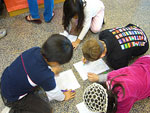BROWSE BY CATEGORY
- Archives and Libraries
- Blogs and Networking
- Bookmark This
- Digital Tools
- Examples of Teaching
- Exhibits
- Film Reviews
- History and Headlines
- Historic Sites and Museums
- Historical Thinking
- Holidays and Heritage
- Issues and Research
- Lesson Plans
- Material and Visual Culture
- Multimedia
- Organizations and Agencies
- Primary Sources
- Professional Development
- Publications
- Student Activities
- Teaching Materials
- Websites
Jennifer Orr Starts the Year

The beginning of the school year is crazy for so many reasons. Teachers have to unpack and set up their classrooms, get to know a whole batch of new students, determine the best way to communicate with parents, and plan engaging lessons designed to get students learning and help teachers assess students’ reading, writing, and math skills.
That list really only begins to scratch the surface of the start of the year reality. The first few weeks of school establish routines and set the tone for the year. This time can also be used to introduce students to the year’s curriculum and to get them excited about it.
Engaging students in different subject areas is critical and will pay off throughout the year. History and social studies are subjects in which many students have a natural interest, one that we just have to encourage.
We can get to know our students through social studies at the beginning of the year through timelines. Create a timeline of your life (or of a part of your life) to share with your students. This will help them get to know you and be an example to teach them about timelines. Then have each student create a timeline of his or her life. You will learn quite a bit about each student as they gain a better understanding of an important history tool.
Picture books are another good option for hooking students on history. Read aloud a book with an unusual perspective, such as Encounter by Jane Yolen, and discuss students’ reactions to it. Books such as this one encourage students to ask questions. Reading a variety of historically based books in the first few weeks of school will support an environment that promotes asking questions and adopting different points of view. These are skills that will serve your students well throughout the year.
Primary sources are also a fabulous introduction to the year’s historical studies. Hang various items, artwork, documents, letters, or records that pertain to your curriculum in your classroom. Just put out one or two at a time. You can hang them up without any introduction and allow students to look at or read them and begin discussions on their own. Again, this will encourage them to ask questions about history. Once students are thinking about the item take a bit of time for a class discussion about it. Allow the students to share their thoughts and questions. Provide them with books or websites that will give them more information. In this way they will gain background knowledge for the year and practice skills that will help them throughout their study of history.
For more information
To start the year with timelines, check out our Teaching Guide on teaching with timelines, or see what Teachinghistory.org blogger Joe Jelen has to say about digital timelines.
Picture books can be a rich secondary sources for prompting questions and provoking analysis. This Teaching Guide offers ideas.
For more ideas on teaching early-elementary students with primary sources, try Jennifer Orr's own earlier blog entry on the subject.
